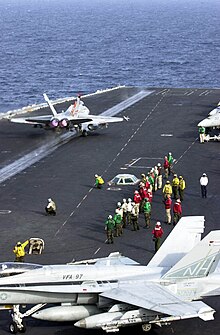Flight system

The on-board flight system is a device that has been used primarily on warships but also partly on merchant ships since the 1920s to accelerate propeller planes or seaplanes to the necessary speed for take-off with the help of a catapult powered by compressed air , steam , rocket propulsion or hydraulics that they can take off on the open sea from board the ship. The systems for take-off support on many modern aircraft carriers can also be counted among the on-board flight systems, since conventional jet aircraft without them would not be able to reach the minimum airspeed on their own in order to be able to take off safely from the carrier.
history
The beginnings
At the end of the First World War , work was being done in Germany on a catapult for the short take-off of a seaplane , from which catapults for use on ships were developed in the 1920s. At this time catapults for use on ships were also being developed in the USA, England, France and Italy.
Interwar period
In the interwar period, the corresponding systems were further developed. So-called catapult ships for the transatlantic airmail traffic of Lufthansa were created mainly on the German side . The planes started by hydraulically operated catapults became bigger and bigger, up to the light four-engine Blohm & Voss Ha 139 . Around the same time, the first large battleships and heavy cruisers (later also light cruisers ) were equipped with on-board flight systems, with which they could be launched if necessary reconnaissance aircraft and, in rare cases, fighter aircraft (e.g. the Italian Littorio ). On some ships, on-board flight systems were sometimes installed over the heavy gun turrets due to lack of space. The German battleships of the Bismarck class and the British King George V class had a particularly characteristic on-board flight system , which was arranged across the width about midships. Also on the seaplane carriers developed in the 1920s, such as the French Commandant Teste and the Japanese Chitose , catapults were used to take off the aircraft from on board.
Second World War
From the Second World War , the seaplane carriers were mostly only used as pure transporters, which operated from bases on the coasts and took off seaplanes, as the corresponding flight operations due to the increased speed of the ships in contrast to earlier times in a closed fleet with the requirements of fast changing threat situations in modern naval warfare were finally no longer compatible. The on-board flight systems on battleships and heavy cruisers turned out to be all the more important for reconnaissance purposes. However, the first really usable aircraft carriers with a flight deck were built before the war , in which the aircraft with wheel landing gear (land aircraft) could also land on board again. Some of these ships had one or two steam- powered catapults on the flight deck, which, however, were significantly longer than those of the previously used designs in order to accelerate the aircraft. A special feature were the British CAM ships , merchant ships equipped with catapults , which carried Hawker Sea Hurricane fighter aircraft on board for their defense from the air (their rather short catapults had a rocket drive , otherwise the acceleration would not have been sufficient). The most extensive on-board flight systems were owned by the battleships (above all the Yamato class or, after conversion to hybrid aircraft carriers in 1944, the two units of the Ise class ) and heavy cruisers ( Mogami after conversion in 1943) of the Imperial Japanese Navy , with several catapults at the stern and a rail system with which the aircraft could be moved on deck. The catapult ships did not disappear entirely in this conflict; The German Reich continued to use them in limited numbers due to the lack of their own aircraft carriers, and in the later phase of the war they were again of great importance for the Japanese kamikaze units .
Post-war until today
With the introduction of helicopters to the navies in the early 1950s, seaplane carriers equipped with conventional on-board flight systems became redundant and decommissioned. These systems also disappeared on the cruisers , with the on- board helicopters gradually finding their way into smaller units such as destroyers and frigates .
Most modern aircraft carriers also have on-board flight systems, so to speak, with which they bring their jet aircraft into the air with the help of a long steam catapult, as they can no longer take off conventionally (i.e. without support) from aircraft decks, because the taxiing speed and excess travel of the carrier cannot more is sufficient to achieve the minimum airspeed that the increasingly heavy modern aircraft needed for lift.
Types of on-board flight systems
General
Older systems
Newer systems
See also
- Board aircraft
- Naval aviators
- Aircraft mother ship
- Seaplane tender
- Auxiliary cruiser
- Light cruiser
- Heavy cruiser
- Battleship
literature
- Siegfried Breyer: FLUGZEUGKREUZER FLUGZEUGMUTTERSCHIFFE FLUGZEUGTENDER to 1945. Podzun-Pallas-Verlag, Wölfersheim-Berstadt, 1994, ISBN 3-7909-0509-7 .
- Frank Omeda: The German aircraft carriers. From the beginning to 1945. E-Book , Kindle Edition 2012.
- Simon Mitterhuber: The German catapult planes and slingshots. Bernard & Graefe Verlag, Bonn, 1st edition, 2004, ISBN 3-7637-6244-2 .


